Things You Should Know About Bees, Wasps, Hornets, Honey Bees, Carpenter Bees, Ground Bees and Yellowjackets
A photo and description of different types of stinging insects, including bees, will help you accurately describe your bee problem to The Bee Hunter of Mass so that he may better assist you when you call.
Remember, “your bee” or its nest may not look exactly like the photo; simply try to find the bee that looks the closest.
Carpenter BeesHornetsBumble BeesWaspsYellow JacketsGround BeesHoney Bees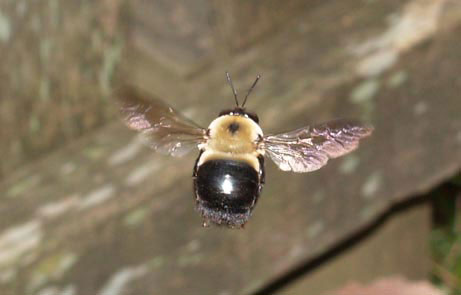
Carpenter Bees
Xylocopa virginica
Carpenter bees, unlike other types of bees, love to burrow in wood. They are often found in wooden decks, eaves, and porches tunneling their homes into yours. Although they are not as aggressive as other types of bees, the expense they create in destroying your home over time makes them just as burdensome.
When carpenter bees drill through wood, they create perfectly round 3/8-inch holes. A common misconception is that the bees are eating the wood or otherwise damaging the structure of your home. In fact, they are simply creating tunnels in which to lay their eggs. While they may destroy a lot of wood, they won’t destroy a house the way termites will – they typically will not destroy the structural part of your home.
Carpenter bees differ from bald-faced hornets and yellowjackets in that they tend to be solitary insects while building their nests close to other carpenter bees.
Hornets (bald/white-faced)
Vespula maculata
Bald-faced hornets are so named because of the white markings on their heads, not because they lack any hair. They are the strongest of all bees in Massachusetts and should be avoided if possible. Hornets resemble yellowjackets, but there are more than 20 hornet species. The hornet is more aggressive than most other bees, wasps, and yellowjackets – keep your distance!
Hornets build their nests in places such as tree branches, eaves or fascia boards on houses, and under decks. Unlike yellow jackets, hornets rarely enter homes through gaps in construction. Hornets’ nests look like grayish paper footballs and are made by the hornets themselves.
Hornets have a stinger that can penetrate even thick clothing. When they sting, they leave more venom than do wasps. And unlike some other insects, such as bees, hornets can stings multiple times. If a human makes a hornet angry enough, it will release pheromones into the air to alert its colony that it is under attack and mobilize the entire clan to come after the offender.
Hornets are actually wasps of the genus Vespa. (Now you know where that popular scooter got its name!)
Hornets are carnivorous and feed on nectar, sugar-rich plant foods, and overripe fruit. They also kill other prey—grasshoppers, locusts, and even honey bees—reducing their corpses to mush and feeding it to their larvae.
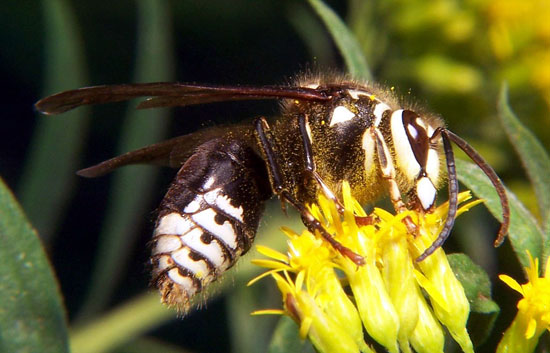
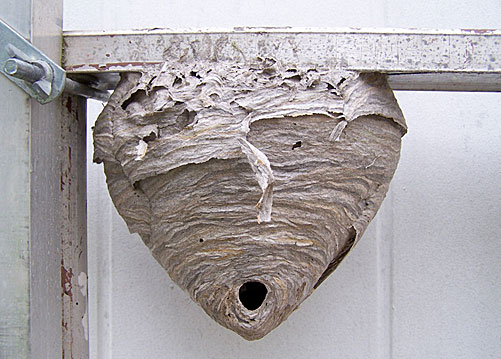
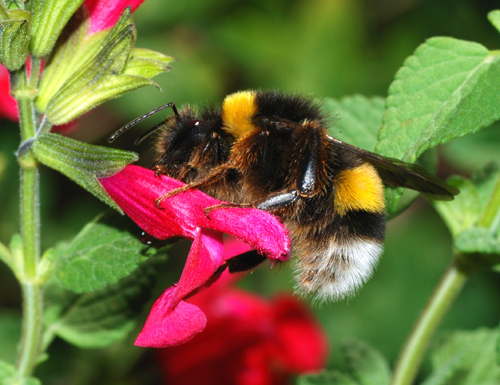
Bumble Bees
Bombus impatiens, Bombus perplexus, Bombus vagans
Although bumblebees make honey, the quantity they produce is far less than that produced by other bees, including the far more well-known honey bee.
Bumblebees love flowers and will often be found inside of them, enjoying the sweet nectar. They are quite docile, but if they happen to decide to make a nest near your home and you don’t want them as neighbors, they can become aggressive in defending their home. Resist the urge to pet them!
Bumblebees are rarely seen, as they build their nests in loose materials like leaves, grass clippings or mulch. You will be able to tell if a bumblebee has built its nest near your home by seeing them coming in and out of your yard consistently.
They usually build nests in attics, but also may be found in underground or near sidewalks and patios.
Bumblebees are fuzzy, yellow and black insects that live in colonies. There are 250 species of bumblebees, and they come in many different colors and sizes.
Unlike a honey bee, and more like a hornet, a bumblebee does not have a jagged stinger, so it won’t get stuck inside your skin, which means it can sting several times.
Bumblebees are more than 30 types of endangered or thought to be extinct. Having flowers and a garden helps keep bumblebees thriving, but it is good to keep your yard free of debris to lessen the chances that bumblebees will want to build a nest under your ladder, a piece of wood or hose.
Wasps
Polistes dominula & Polistes fuscatus
Wasps are not bees, although they are often confused with bees. Wasps tend to be more slender and less hairy than bees, and unlike bees, they do not have an anchor on their stinger that gets stuck in your skin upon a sting. Therefore, wasps can sting multiple times and release powerful venom into your body. Also, unlike bees, wasps do not make honey.
Wasps come in many different colors and sizes. Some wasps are red, yellow, black and blue; some are larger than others. There are more than 100,000 species of wasps worldwide and 4,000 types in the United States; bald-faced hornets and yellowjackets are among the most common species.
Like bees, wasps eat nectar and fruits; however, they also eat insects and caterpillars. Unlike bees, wasps do not make honey. Some species of wasps do pollinate other flowers and plants, like bees. They are found all over the world except in Polar Regions.
Wasps prey on many other pests and insects, and they are used as a form of pest control themselves in agricultural settings.
When wasps die, they release pheromones in the air that their comrades in the hive can smell. This serves as a warning signal to the other wasps, but if you are the cause of their death and those pheromones land on your skin, it could trigger an entire wasp colony to come after you.
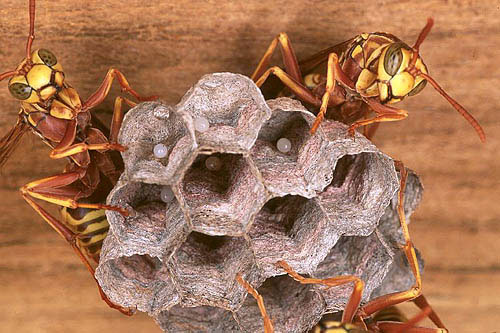
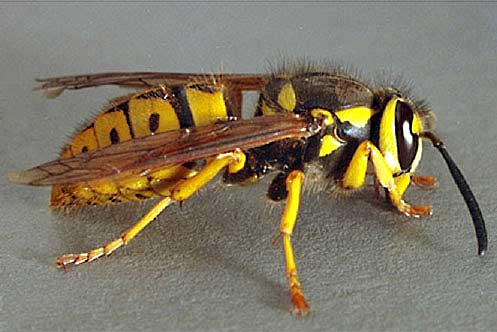
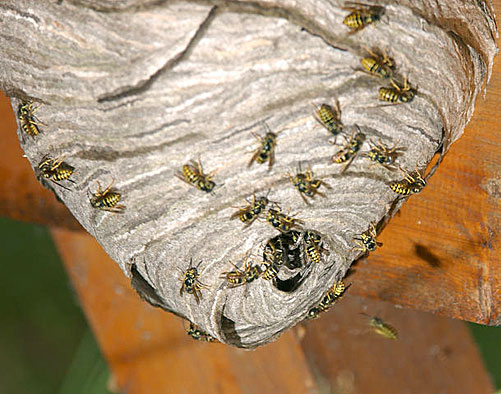
Yellow Jackets
Vespula maculifrons, Vespula germanica, Vespula vulgaris
Like hornets, yellowjackets are also wasps. Although they are slightly smaller than hornets and have a yellow and black coloration, my Pittsburgh colleague, the Bee Hunter of Pittsburgh, calls them “Steeler” bees!
Yellowjackets are usually seen at picnics, hovering around soda cans or crawling across food. These bees love sweets and meat, but they also eat spiders and other insects.
Because they like human food, these bees often build their nests in or around homes, especially under decks around garages. Their nest is football-shaped and looks like a gray paper mache. If you see them flying around your home but can’t find their nest, their home is probably inside of YOUR home but it may not be visible. If you listen closely you may even hear them – they may sound like leaves rustling. If this happens and you see the hole, please do NOT seal the hole shut because you inadvertently will be trapping the bees inside your house.
If you see bees in or around your home or if you have been stung by a bee, wasp, hornet, or yellowjacket, please read my Bee Removal FAQ page for more information about what to do.
Yellow Jackets / Ground Bees
Vespula maculifrons, Vespula vulgaris
Yellowjackets and ground bees are similar in appearance, but ground bees are typically encountered when using a lawn mower.
Ground bees construct hives two inches to two feet underground, often using existing holes in your yard. The hives may be smaller than those of other yellow jackets, but ground bees are aggressive and easily agitated. You may not even see them until it is too late–then you will know they’re there! See my FAQ page for more information about what not to do with a ground bees’ nest.
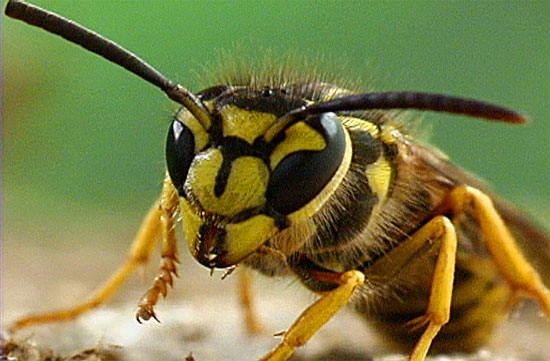
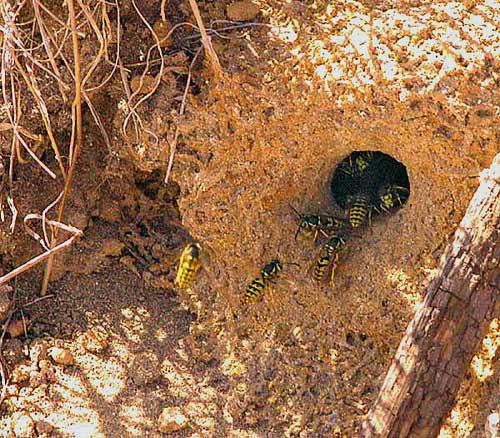

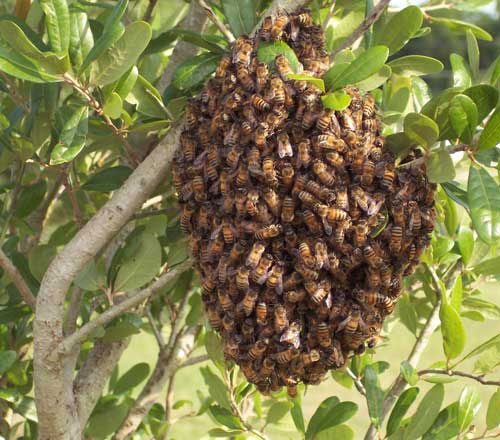
Honey Bees
Apis mellifera
Honeybees are the “good” bees. I will try to capture a hive or swarm of honeybees alive if I can, rather than killing them. Their role in pollinating crops and plants is important and beneficial to our society.
Honey bees are fascinating creatures. They are the only animals that can make food on a large enough scale for humans to consume, and they pollinate over 100 types of crops in the U.S., giving our food flavor and life: strawberries, apples, nuts and coffee, just to name a few. One out of every three bites of our food is pollinated by a honey bee.
Honey bees build hives that can weigh over 100 pounds and contain thousands and thousands of bees. If they are nesting inside your house, their nest will typically run between the 2×4 or 2×6 joists along your floors and/or walls.
Honey bees will sometimes leave their hive in search of a new home. This is called a swarm; the bees fly together in a large group that looks like a tornado until they get tired, then they rest on branches or other objects nearby. A swarm has not yet developed a hive and can usually be removed from your property without killing them.
If you have heard of “Africanized” honey bees, they are much more aggressive than their European counterparts. They generally require a much warmer climate to survive and are not likely to be found in Massachusetts.
Honey bees have a barb on their stingers. If the bee stings someone, the stinger can anchor in the victim’s skin. If this happens, the bee’s venom pouch will rip from its abdomen and cause an abdominal rupture, leading to the bee’s death.
The honey bee’s wings beat 11,400 times per minute, which is why they make such a loud “bzzz”. A honey bee visits between 50-100 flowers during a trip out of the hive to collect nectar, which it uses to make honey. The taste of honey varies depending on which flowers the bees are visiting.
How much honey will a honey bee make in its lifetime? Only about one or two teaspoons! But an entire bee colony can produce more than 100 pounds of honey that can be collected.
Contrary to popular belief, female bees do all of the work in a beehive. Male bees are called drones and they guard the hive and wait around until the Queen bee decides whether she’s ready to mate with one of them or not. But if she does choose them, it might not be the best of luck for them since they will die soon after mating!
Feeling a little forgetful lately? Try eating honey – it’s the only food that contains pinocembrin, an antioxidant that improves memory and brain function.
Colony Collapse Disorder (CCD) is a phenomenon that has been occurring in recent years, causing bee populations to rapidly disappear. Researchers have yet to determine the cause of this problem and what can be done about it. When removing honeybees from an area, the Bee Hunter of Massachusetts tries to find another home for them by handing them over to a beekeeper, where they will be happy and not harm anyone. The best thing you can do to help the bee population is plant flowers in your yard or become a beekeeper yourself and harvest your own honey!
